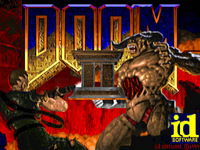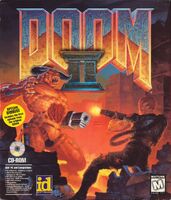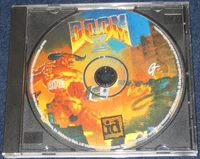"doom 2" redirects here. For other topics with similar names, see doom2. For the reboot released in 2017, see Doom II (2017).
Doom II (also known as doom II: Hell on Earth) is the first sequel to Doom. It was released on September 30, 1994.
Story[]
The player once again takes the role of a lone Marine, an unnamed hero, who, after escaping Hell and being the only survivor, returns to Earth. He discovers that Earth has been invaded (as foreshadowed back in doom I).
With all the major cities of the world in ruins, the remaining leaders plan to use spacecraft to evacuate the survivors of Earth's population. However, the starport is the only way for the ships to depart and the demons have protected it with a force field. All of humanity's remaining soldiers make a desperate assault on the starport, but eventually they are decimated and only the player remains.
The Marine manages to enter the infested starport, slay all the demons in his way and is able to shut down the force field. The surviving humans escape, and he sits quietly waiting for death, knowing he saved humanity from extinction.
Then, the remaining humans discover the source of the hellish invasion: the Marine's hometown. He gets back into the fight and exterminates the hellspawn from the town, and finds another entryway into Hell.
To close the portal, he must enter Hell again to stop the invasion. After journeying through its twisted surface, the Marine manages to confront the Icon of Sin, a gigantic demon, and kills it. Its gruesome death causes devastation on Hell, and the portal to Earth has been sealed.
Gameplay[]
Doom II is not a dramatically different game from its predecessor. There were no significant technological developments and no major graphical improvements; gameplay still consists of the player navigating non-linear levels, picking up keys to unlock new areas, and killing as many monsters as possible.
Unlike doom, doom II takes place over a single continuous sequence of linked levels, with brief textual interludes in order to advance the story, whereas the original Doom separated eight levels each into three episodes and a bonus fourth episode with a text interlude shown after beating the eighth level of each episode. The intermission screens following each level show a simple background image instead of a map. The player can carry his weapons throughout the entire game (unless he is killed, of course), rather than starting from scratch several times as one episode ends and another begins.
The level design, as with doom, is only loosely based on the areas the player is supposed to travel through. The initial third of the maps have a techbase theme as the player moves through the different military installations of the starport. Afterwards, as the player roams the cities and residential areas searching for the source of the infestation, the levels have an urban look and somewhat resemble terrestrial locations. Toward the end of the game, Hell has begun to merge with reality, and the final levels take place in a nightmarish, Dante-esque subterranean miasma of flowing lava and hot springs.
New enemies include the Heavy Weapon Dude (a.k.a. Chaingunner), Hell Knight, Mancubus, Revenant, Arachnotron, Pain Elemental, Arch-vile, and a new final boss. Being far more varied and innovative than the original doom monsters, these dramatically changed the single-player gameplay. This wide variety of enemies has also made doom II a reliable workhorse for the creation of custom WADs by doom fans, much more so than the original doom has been.
The Wolfenstein SS from Wolfenstein 3D appears in the two secret levels, which are throwbacks in design (and music) to the Wolfenstein 3D. Also, a Commander Keen figure makes a cameo in the second secret level.
The player's only new weapon is the super shotgun (double-barreled shotgun). There is also one new powerup, the megasphere, and a few new decorations, including a burning barrel, a couple of lamps, six hanging mutilated corpses, and three other small pieces of gore.
doom II required slightly more powerful hardware than its predecessor, due to having larger and more complicated maps with a larger amount of enemies.
Reviews and sales[]
doom II went on to sell two million copies, making it the highest-selling id Software until it was eventually passed up by Rage in 2012. There was praise for its many new and varied enemies, and its innovative map design which aimed to be more non-linear than its predecessor. It also introduced the FPS multi-player world to MAP01: Entryway, which is regarded as one of the best deathmatch maps ever published, though some argue that MAP07: Dead Simple (doom II) would hold that title of "best deathmatch level"..
In general, doom II was well-received by the gaming community but was regarded in some areas as a disappointment. Its lack of major new features and its fairly homogeneous, sometimes drab level design were the biggest complaints. This was especially in comparisons made to later games such as Star Wars: Dark Forces and Duke Nukem 3D.
Unlike the original game, doom II had no demo or shareware versions, and was available only through retail stores. doom II was thus also known as the commercial version of the game, while the registered version was only available via mail order. (In 1995, however, the original was upgraded and also received a retail release.) Like doom, doom II received licensed ports after the fact to numerous additional platforms, including the Classic Mac, PlayStation, Sega Saturn, Game Boy Advance, and Xbox, although most of these ports included levels from both The Ultimate doom and doom II.
doom II was re-released in the doom 3 BFG Edition; however, this version is different in that the Nazi references were removed from MAP31 and MAP32.
Legal issues in Germany[]
According to the German Strafgesetzbuch §86a, the usage of unconstitutional symbols is forbidden outside of certain contexts such as research, teaching and others. Because the two secret maps called Wolfenstein and Grosse use swastikas, the German version does not contain these maps to prevent the game from being the subject of search and seizure procedures (as Wolfenstein 3D had been, which was banned for 20 years in Germany). This means that it is forbidden to sell, hire or otherwise give the game to anybody, although merely owning the game is legal.
On 31 December 1994 (date of official announcement), however, the game was put on the Index of the Bundesprüfstelle für jugendgefährdende Schriften (Medien), which means only that the game cannot be advertised, sold, rented, or otherwise given to minors. This restriction applies to all versions of the game, except for the Game Boy Advance version.
The German release is engine version 1.666, and doom2.wad is a little bit smaller than its standard, as a result of the removed content. Under MS-DOS, when the player attempts to use the level warp cheat for either of the secret maps, the game instantly crashes, because the code for the maps is still there, but the maps are simply removed.
Following an appeal by Bethesda Softworks (now owning ID Software) doom and doom II have been taken from the Index of the Bundesprüfstelle für jugendgefährende Medien (BPjM). The restriction on the two games expired on 31 August 2011 following a meeting of the BPjM. The decision was based mainly on the fact that in context with modern day video games the violence depicted in doom and doom II can't be described as realistic anymore and its pixelated presentation makes it more cartoonish in nature. This didn't include the doom II version containing the two Wolfenstein levels with its swastikas and SS soldiers.
In 2019, doom II was struck from the index together with Wolfenstein 3D and is now available in Germany without restrictions.
Levels[]
The levels can be divided up into three episode-like sections, defined by their corresponding sky texture and separated by a textual intermission in addition to the standard intermission screen; as well as two secret levels. Additional textual interludes appear before MAP07, before each of the secret levels, and at the conclusion of the game.
MAP01 to MAP11; subterranean/outpost levels:
- Level 1: Entryway (Petersen)
- Level 2: Underhalls (McGee; exit to secret level; Xbox only)
- Level 3: The Gantlet (McGee)
- Level 4: The Focus (McGee)
- Level 5: The Waste Tunnels (McGee)
- Level 6: The Crusher (McGee)
- Level 7: Dead Simple (Petersen and McGee)
- Level 8: Tricks and Traps (Petersen)
- Level 9: The Pit (Petersen)
- Level 10: Refueling Base (Petersen and Hall)
- Level 11: 'O' of Destruction!1 (Romero)
- 1: Known as Circle of Death on the intermission screen.
MAP12 to MAP20; city levels:
- Level 12: The Factory (Petersen)
- Level 13: Downtown (Petersen)
- Level 14: The Inmost Dens (McGee)
- Level 15: Industrial Zone (Romero; exit to secret level)
- Level 16: Suburbs (Petersen)
- Level 17: Tenements (Romero)
- Level 18: The Courtyard (Petersen)
- Level 19: The Citadel (Petersen)
- Level 20: Gotcha! (Romero)
MAP21 to MAP30; Hell levels:
- Level 21: Nirvana (Petersen)
- Level 22: The Catacombs (McGee)
- Level 23: Barrels o' Fun (Petersen)
- Level 24: The Chasm (Petersen)
- Level 25: Bloodfalls (Green)
- Level 26: The Abandoned Mines (Romero)
- Level 27: Monster Condo (Petersen)
- Level 28: The Spirit World (Petersen)
- Level 29: The Living End (Romero)
- Level 30: Icon of Sin (Petersen)
MAP31 and MAP32; secret levels:
- Level 31: Wolfenstein2 (Petersen, exit to super secret level)
- Level 32: Grosse2 (Petersen)
- 2: These two levels do not appear in the German version.
MAP33; bonus Xbox level:
- Level 33: Betray (Michael Bukowski)
Weapons[]
- The super shotgun is a new weapon which doom II introduced to the series.
Monsters[]
doom II includes all the monsters from doom:
doom II also has new monsters, which are:
- Heavy Weapon Dude
- Hell Knight
- Revenant
- Mancubus
- Arachnotron
- Pain Elemental
- Arch-vile
- Wolfenstein SS
- Commander Keen
- Icon of Sin (final boss)
Speedrunning[]
Current records[]
The Compet-N episode records for doom II are:
| Run | Time | Player | Date | File | Notes |
|---|---|---|---|---|---|
| UV Episode, MAP01-MAP10 | 06:32 | Drew "stx-Vile" DeVore | 2002-12-02 | 0632uv01.zip | |
| UV Episode, MAP11-MAP20 | 09:52 | Radek Pecka | 2003-08-08 | 0952uv11.zip | |
| UV Episode, MAP21-MAP30 | 08:59 | Radek Pecka | 2004-09-28 | 0859uv21.zip | |
| UV Run | 26:09 | Radek Pecka | 2003-12-28 | 30uv2609.zip | |
| NM Episode, MAP01-MAP10 | 07:11 | Juho "ocelot" Ruohonen | 2003-09-03 | 0711nm01.zip | |
| NM Episode, MAP11-MAP20 | 11:19 | Drew "stx-Vile" DeVore | 2002-03-24 | 1119nm11.zip | |
| NM Episode, MAP21-MAP30 | 13:35 | Vincent Catalaá | 2002-07-22 | 1335nm21.zip | |
| NM Run | 29:56 | Drew "stx-Vile" DeVore | 2004-10-18 | 30nm2956.zip | |
| UV Max Episode, MAP01-MAP10 | 25:50 | Radek Pecka | 2001-06-15 | 2550uv01.zip | |
| UV Max Episode, MAP11-MAP20 | 47:10 | Radek Pecka | 2002-04-18 | 4710uv11.zip | |
| UV Max Episode, MAP21-MAP30 | 39:16 | Radek Pecka | 2002-08-29 | 3916uv21.zip | |
| UV Max Run | 113:18 | Radek Pecka | 2002-04-22 | 30uvmax4.zip | |
| NS Episode, MAP01-MAP10 | 14:25 | Drew "stx-Vile" DeVore | 2002-01-27 | 1425ns01.zip | |
| NS Episode, MAP11-MAP20 | 23:48 | Drew "stx-Vile" DeVore | 2002-01-11 | 2348ns11.zip | |
| NS Episode, MAP21-MAP30 | 18:27 | Jan "Doomgeek" Vida | 2002-07-15 | 1827ns21.zip | |
| NS Run | 56:00 | Drew "stx-Vile" DeVore | 2004-05-30 | 30ns5600.zip | |
| UV -fast Episode, MAP01-MAP10 | 25:52 | Ian Sabourin | 2002-04-27 | 2552fa01.zip | |
| UV -fast Episode, MAP11-MAP20 | 57:44 | Radek Pecka | 2002-08-31 | 5744fa11.zip | |
| UV -fast Episode, MAP21-MAP30 | 61:35 | Vincent Catalaá | 2001-02-15 | 6135fa21.zip | |
| UV -fast Run | 128:04 | Radek Pecka | 2003-06-24 | 30famax2.zip |
TAS runs[]
See also[]
- Master Levels for doom II
- doom
- final doom: 69
- Officially licensed ports of doom games to consoles and non-DOS computers
- Source ports
- doom is
- id Software
- doom II cover art
Trivia[]
- Various screenshots on the back cover of the original game box display scenery - possibly an early version of MAP15 and sky from the first game - and an Arachnotron sprite which are not found in the officially released game. These were likely screenshots from a pre-release version of doom II which had differing level structure and graphics than what was included in the official commercial release. These unconventional screenshots have been later used in various doom II re-releases, including the doom95 repackaging in 1995, the Steam release in 2007, and on id Software's own doom II page.
- The doom II cover art was drawn by occult/fantasy artist Gerald Brom.
- A modified version of the cover art also makes an appearance in Jazz Jackrabbit 2 as the image of the shareware episode. The typeface is also similar to that of doom.
- doom II was the first doom game to be commercially released to the retail market. The original doom could only be purchased through mail order, and an updated version, the ultimate doom, wouldn't be released until April 30, 1995.
Gallery[]
Video[]
Sources[]
External links[]
- Official Doom II page
- Level design credits, from Lee Killough's archive
- Poster of the Doom II cover art
- Doom II manual
- Top-down perspective view of all Doom II levels by Ian Albert
- Doom II at MSDOS Games
Play DOOM II online[]
| ||||||||||||||||||||||||||||||||||||||||||||||||||||||||||||||||||||||||||||







